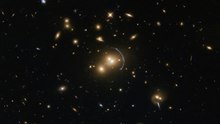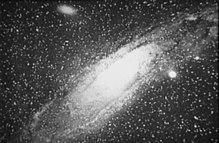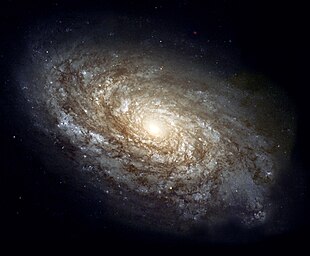Galaxy theme by Igotamic
Download: Galaxy.p3t

(1 background, wallpaper HD only)
A galaxy is a system of stars, stellar remnants, interstellar gas, dust, and dark matter bound together by gravity.[1][2] The word is derived from the Greek galaxias (γαλαξίας), literally 'milky', a reference to the Milky Way galaxy that contains the Solar System. Galaxies, averaging an estimated 100 million stars,[3] range in size from dwarfs with less than a thousand stars,[4] to the largest galaxies known – supergiants with one hundred trillion stars, each orbiting its galaxy's center of mass. Most of the mass in a typical galaxy is in the form of dark matter, with only a few percent of that mass visible in the form of stars and nebulae. Supermassive black holes are a common feature at the centres of galaxies.
Galaxies are categorised according to their visual morphology as elliptical,[5] spiral, or irregular.[6] The Milky Way is an example of a spiral galaxy. It is estimated that there are between 200 billion[7] (2×1011) to 2 trillion[8] galaxies in the observable universe. Most galaxies are 1,000 to 100,000 parsecs in diameter (approximately 3,000 to 300,000 light years) and are separated by distances in the order of millions of parsecs (or megaparsecs). For comparison, the Milky Way has a diameter of at least 26,800 parsecs (87,400 ly)[9][a] and is separated from the Andromeda Galaxy, its nearest large neighbour, by just over 750,000 parsecs (2.5 million ly.)[12]
The space between galaxies is filled with a tenuous gas (the intergalactic medium) with an average density of less than one atom per cubic metre. Most galaxies are gravitationally organised into groups, clusters and superclusters. The Milky Way is part of the Local Group, which it dominates along with the Andromeda Galaxy. The group is part of the Virgo Supercluster. At the largest scale, these associations are generally arranged into sheets and filaments surrounded by immense voids.[13] Both the Local Group and the Virgo Supercluster are contained in a much larger cosmic structure named Laniakea.[14]
Etymology[edit]
The word galaxy was borrowed via French and Medieval Latin from the Greek term for the Milky Way, galaxías (kúklos) γαλαξίας (κύκλος)[15][16] 'milky (circle)', named after its appearance as a milky band of light in the sky. In Greek mythology, Zeus places his son, born by a mortal woman, the infant Heracles, on Hera's breast while she is asleep so the baby will drink her divine milk and thus become immortal. Hera wakes up while breastfeeding and then realises she is nursing an unknown baby: she pushes the baby away, some of her milk spills, and it produces the band of light known as the Milky Way.[17][18]
In the astronomical literature, the capitalised word "Galaxy" is often used to refer to the Milky Way galaxy, to distinguish it from the other galaxies in the observable universe. The English term Milky Way can be traced back to a story by Geoffrey Chaucer c. 1380:
See yonder, lo, the Galaxyë
Which men clepeth the Milky Wey,
For hit is whyt.— Geoffrey Chaucer, The House of Fame[16]
Galaxies were initially discovered telescopically and were known as spiral nebulae. Most 18th- to 19th-century astronomers considered them as either unresolved star clusters or anagalactic nebulae, and were just thought of as a part of the Milky Way, but their true composition and natures remained a mystery. Observations using larger telescopes of a few nearby bright galaxies, like the Andromeda Galaxy, began resolving them into huge conglomerations of stars, but based simply on the apparent faintness and sheer population of stars, the true distances of these objects placed them well beyond the Milky Way. For this reason they were popularly called island universes, but this term quickly fell into disuse, as the word universe implied the entirety of existence. Instead, they became known simply as galaxies.[19]
Nomenclature[edit]

Millions of galaxies have been catalogued, but only a few have well-established names, such as the Andromeda Galaxy, the Magellanic Clouds, the Whirlpool Galaxy, and the Sombrero Galaxy. Astronomers work with numbers from certain catalogues, such as the Messier catalogue, the NGC (New General Catalogue), the IC (Index Catalogue), the CGCG (Catalogue of Galaxies and of Clusters of Galaxies), the MCG (Morphological Catalogue of Galaxies), the UGC (Uppsala General Catalogue of Galaxies), and the PGC (Catalogue of Principal Galaxies, also known as LEDA). All the well-known galaxies appear in one or more of these catalogues but each time under a different number. For example, Messier 109 (or "M109") is a spiral galaxy having the number 109 in the catalogue of Messier. It also has the designations NGC 3992, UGC 6937, CGCG 269–023, MCG +09-20-044, and PGC 37617 (or LEDA 37617), among others.[20] Millions of fainter galaxies are known by their identifiers in sky surveys such as the Sloan Digital Sky Survey.[21]
Observation history[edit]
Milky Way[edit]
Greek philosopher Democritus (450–370 BCE) proposed that the bright band on the night sky known as the Milky Way might consist of distant stars.[22] Aristotle (384–322 BCE), however, believed the Milky Way was caused by "the ignition of the fiery exhalation of some stars that were large, numerous and close together" and that the "ignition takes place in the upper part of the atmosphere, in the region of the World that is continuous with the heavenly motions."[23] Neoplatonist philosopher Olympiodorus the Younger (c. 495–570 CE) was critical of this view, arguing that if the Milky Way was sublunary (situated between Earth and the Moon) it should appear different at different times and places on Earth, and that it should have parallax, which it did not. In his view, the Milky Way was celestial.[24]
According to Mohani Mohamed, Arabian astronomer Ibn al-Haytham (965–1037) made the first attempt at observing and measuring the Milky Way's parallax,[25] and he thus "determined that because the Milky Way had no parallax, it must be remote from the Earth, not belonging to the atmosphere."[26] Persian astronomer al-Biruni (973–1048) proposed the Milky Way galaxy was "a collection of countless fragments of the nature of nebulous stars."[27] Andalusian astronomer Avempace (d. 1138) proposed that it was composed of many stars that almost touched one another, and appeared to be a continuous image due to the effect of refraction from sublunary material,[23][28] citing his observation of the conjunction of Jupiter and Mars as evidence of this occurring when two objects were near.[23] In the 14th century, Syrian-born Ibn Qayyim al-Jawziyya proposed the Milky Way galaxy was "a myriad of tiny stars packed together in the sphere of the fixed stars."[29]
Actual proof of the Milky Way consisting of many stars came in 1610 when the Italian astronomer Galileo Galilei used a telescope to study it and discovered it was composed of a huge number of faint stars.[30][31] In 1750, English astronomer Thomas Wright, in his An Original Theory or New Hypothesis of the Universe, correctly speculated that it might be a rotating body of a huge number of stars held together by gravitational forces, akin to the Solar System but on a much larger scale, and that the resulting disk of stars could be seen as a band on the sky from a perspective inside it.[b][33][34] In his 1755 treatise, Immanuel Kant elaborated on Wright's idea about the Milky Way's structure.[35]

The first project to describe the shape of the Milky Way and the position of the Sun was undertaken by William Herschel in 1785 by counting the number of stars in different regions of the sky. He produced a diagram of the shape of the galaxy with the Solar System close to the center.[36][37] Using a refined approach, Kapteyn in 1920 arrived at the picture of a small (diameter about 15 kiloparsecs) ellipsoid galaxy with the Sun close to the center. A different method by Harlow Shapley based on the cataloguing of globular clusters led to a radically different picture: a flat disk with diameter approximately 70 kiloparsecs and the Sun far from the centre.[34] Both analyses failed to take into account the absorption of light by interstellar dust present in the galactic plane; but after Robert Julius Trumpler quantified this effect in 1930 by studying open clusters, the present picture of the Milky Way galaxy emerged.[38]
Distinction from other nebulae[edit]
A few galaxies outside the Milky Way are visible on a dark night to the unaided eye, including the Andromeda Galaxy, Large Magellanic Cloud, Small Magellanic Cloud, and the Triangulum Galaxy. In the 10th century, Persian astronomer Abd al-Rahman al-Sufi made the earliest recorded identification of the Andromeda Galaxy, describing it as a "small cloud".[39] In 964, he probably mentioned the Large Magellanic Cloud in his Book of Fixed Stars, referring to "Al Bakr of the southern Arabs",[40] since at a declination of about 70° south it was not visible where he lived. It was not well known to Europeans until Magellan's voyage in the 16th century.[41][40] The Andromeda Galaxy was later independently noted by Simon Marius in 1612.[39]
In 1734, philosopher Emanuel Swedenborg in his Principia speculated that there might be other galaxies outside that were formed into galactic clusters that were minuscule parts of the universe that extended far beyond what could be seen. These views "are remarkably close to the present-day views of the cosmos."[42] In 1745, Pierre Louis Maupertuis conjectured that some nebula-like objects were collections of stars with unique properties, including a glow exceeding the light its stars produced on their own, and repeated Johannes Hevelius's view that the bright spots were massive and flattened due to their rotation.[35] In 1750, Thomas Wright correctly speculated that the Milky Way was a flattened disk of stars, and that some of the nebulae visible in the night sky might be separate Milky Ways.[34][43]

Toward the end of the 18th century, Charles Messier compiled a catalog containing the 109 brightest celestial objects having nebulous appearance. Subsequently, William Herschel assembled a catalog of 5,000 nebulae.[34] In 1845, Lord Rosse examined the nebulae catalogued by Herschel and observed the spiral structure of Messier object M51, now known as the Whirlpool Galaxy.[44][45]
In 1912, Vesto M. Slipher made spectrographic studies of the brightest spiral nebulae to determine their composition. Slipher discovered that the spiral nebulae have high Doppler shifts, indicating that they are moving at a rate exceeding the velocity of the stars he had measured. He found that the majority of these nebulae are moving away from us.[46][47]
In 1917, Heber Doust Curtis observed nova S Andromedae within the "Great Andromeda Nebula", as the Andromeda Galaxy, Messier object M31, was then known. Searching the photographic record, he found 11 more novae. Curtis noticed that these novae were, on average, 10 magnitudes fainter than those that occurred within this galaxy. As a result, he was able to come up with a distance estimate of 150,000 parsecs. He became a proponent of the so-called "island universes" hypothesis, which holds that spiral nebulae are actually independent galaxies.[48]
In 1920 a debate took place between Harlow Shapley and Heber Curtis, the Great Debate, concerning the nature of the Milky Way, spiral nebulae, and the dimensions of the universe. To support his claim that the Great Andromeda Nebula is an external galaxy, Curtis noted the appearance of dark lanes resembling the dust clouds in the Milky Way, as well as the significant Doppler shift.[49]
In 1922, the Estonian astronomer Ernst Öpik gave a distance determination that supported the theory that the Andromeda Nebula is indeed a distant extra-galactic object.[50] Using the new 100-inch Mt. Wilson telescope, Edwin Hubble was able to resolve the outer parts of some spiral nebulae as collections of individual stars and identified some Cepheid variables, thus allowing him to estimate the distance to the nebulae: they were far too distant to be part of the Milky Way.[51] In 1926 Hubble produced a classification of galactic morphology that is used to this day.[52][53]
Multi-wavelength observation[edit]
Advances in astronomy have always been driven by technology. After centuries of success in optical astronomy, recent decades have seen major progress in other regions of the electromagnetic spectrum.[54]
The dust present in the interstellar medium is opaque to visual light. It is more transparent to far-infrared, which can be used to observe the interior regions of giant molecular clouds and galactic cores in great detail.[55] Infrared is also used to observe distant, red-shifted galaxies that were formed much earlier. Water vapor and carbon dioxide absorb a number of useful portions of the infrared spectrum, so high-altitude or space-based telescopes are used for infrared astronomy.[56]
The first non-visual study of galaxies, particularly active galaxies, was made using radio frequencies. The Earth's atmosphere is nearly transparent to radio between 5 MHz and 30 GHz. The ionosphere blocks signals below this range.[57] Large radio interferometers have been used to map the active jets emitted from active nuclei. Radio telescopes can also be used to observe neutral hydrogen (via 21 cm radiation), including, potentially, the non-ionized matter in the early universe that later collapsed to form galaxies.[58]
Ultraviolet and X-ray telescopes can observe highly energetic galactic phenomena. Ultraviolet flares are sometimes observed when a star in a distant galaxy is torn apart from the tidal forces of a nearby black hole.[59] The distribution of hot gas in galactic clusters can be mapped by X-rays. The existence of supermassive black holes at the cores of galaxies was confirmed through X-ray astronomy.[60]
Modern research[edit]

In 1944, Hendrik van de Hulst predicted that microwave radiation with wavelength of 21 cm would be detectable from interstellar atomic hydrogen gas;[62] and in 1951 it was observed. This radiation is not affected by dust absorption, and so its Doppler shift can be used to map the motion of the gas in this galaxy. These observations led to the hypothesis of a rotating bar structure in the center of this galaxy.[63] With improved radio telescopes, hydrogen gas could also be traced in other galaxies. In the 1970s, Vera Rubin uncovered a discrepancy between observed galactic rotation speed and that predicted by the visible mass of stars and gas. Today, the galaxy rotation problem is thought to be explained by the presence of large quantities of unseen dark matter.[64][65]
Beginning in the 1990s, the Hubble Space Telescope yielded improved observations. Among other things, its data helped establish that the missing dark matter in this galaxy could not consist solely of inherently faint and small stars.[66] The Hubble Deep Field, an extremely long exposure of a relatively empty part of the sky, provided evidence that there are about 125 billion (1.25×1011) galaxies in the observable universe.[67] Improved technology in detecting the spectra invisible to humans (radio telescopes, infrared cameras, and x-ray telescopes) allows detection of other galaxies that are not detected by Hubble. Particularly, surveys in the Zone of Avoidance (the region of sky blocked at visible-light wavelengths by the Milky Way) have revealed a number of new galaxies.[68]
A 2016 study published in The Astrophysical Journal, led by Christopher Conselice of the University of Nottingham, used 20 years of Hubble images to estimate that the observable universe contained at least two trillion (2×1012) galaxies.[69][70] However, later observations with the New Horizons space probe from outside the zodiacal light reduced this to roughly 200 billion (2×1011).[71][72]
Types and morphology[edit]

Galaxies come in three main types: ellipticals, spirals, and irregulars. A slightly more extensive description of galaxy types based on their appearance is given by the Hubble sequence. Since the Hubble sequence is entirely based upon visual morphological type (shape), it may miss certain important characteristics of galaxies such as star formation rate in starburst galaxies and activity in the cores of active galaxies.[6]
Many galaxies are thought to contain a supermassive black hole at their center. This includes the Milky Way, whose core region is called the Galactic Center.[73]
Ellipticals[edit]
The Hubble classification system rates elliptical galaxies on the basis of their ellipticity, ranging from E0, being nearly spherical, up to E7, which is highly elongated. These galaxies have an ellipsoidal profile, giving them an elliptical appearance regardless of the viewing angle. Their appearance shows little structure and they typically have relatively little interstellar matter. Consequently, these galaxies also have a low portion of open clusters and a reduced rate of new star formation. Instead, they are dominated by generally older, more evolved stars that are orbiting the common center of gravity in random directions. The stars contain low abundances of heavy elements because star formation ceases after the initial burst. In this sense they have some similarity to the much smaller globular clusters.[74]
Type-cD galaxies[edit]



